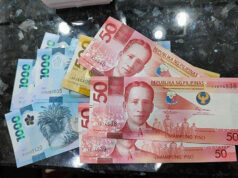Yields on gov’t securities end flat as US curve inverts
YIELDS ON government debt papers traded at the secondary market were flat last Friday amid a slew of developments, most notably the inversion of the US Treasury yield curve, driving investors towards safe-haven assets.
Week on week, government securities’ (GS) yields were up by a mere 0.4 basis point (bp), according to the PHP Bloomberg Valuation Service (BVAL) Reference Rates as of Aug. 16 published on the Philippine Dealing System’s website.
At the secondary market on Friday, at the short end of the curve, the 182- and 364-day Treasury bills (T-bill) went down by 9.1 bps and 0.6 bp to 3.512% and 3.713%, respectively. The movement of the 91-day debt paper was muted with a 0.1 bp climb, yielding 3.376%.
At the belly, yields on the four-, five-, and seven-year Treasury bonds (T-bond) fell by 2.8 bps, 5 bps, and 4.9 bps to 4.035%, 4.109%, and 4.254%. Meanwhile, rates of the two- and three-year T-bonds inched up by 3.3 bps (3.89%) and 0.2 bp (3.962%), respectively.
At the long end, the 10-year T-bond saw its yield go up by 2.8 bps to 4.4%. Yields on the 20- and 25-year tenors also went up by 10.4 bps each to fetch 4.804% and 4.801%, respectively.
“External factors that supported the easing of some local interest rate benchmarks, especially the short-term tenors, include the inversion of US interest rate yield curve for the first time since 2007 and also the inversion of the yield curve in the UK (first time since 2008) and in other developed countries amid concerns over slower global economic growth/outlook,” said Rizal Commercial Banking Corp. (RCBC) economist Michael L. Ricafort.
Meanwhile, “[m]arket expectations of another 0.25-bp cut in the local policy rates and a possible cut in reserve requirement ratio (RRR) of banks of about 100 bps by September at the earliest, and the sustained decline in inflation especially in the coming months of 2019 partly supported the easing of most shorter-term local interest rate benchmarks recently,” Mr. Ricafort added.
ING Bank N.V.-Manila senior economist Nicholas Antonio T. Mapa attributed last week’s bond movements mostly to profit-taking. “Bond markets finally decided to take profit from the recent rally with market players opting to sit on cash with concerns about the escalation in trade war and the ill effects of global growth,” he said.
“Foreign investors may have started the selling with local players following suit,” he added.
Yields on the 10-year US Treasuries were below that of the US two-year debt papers last Thursday for the first time since 2007 or just before the global recession.
Likewise, the 30-year US Treasury bond yield slumped below 2% for the first time.
This resulted in an inverted yield curve, which happens when shorter-term interest rates are higher than longer-term bond yields. As investors usually expect to get paid a higher rate of return in longer-dated debt papers, an inverted yield curve usually signals an approaching economic recession.
US-China tensions also escalated after Washington accused Beijing of being a “currency manipulator” for the first time since 1994.
Prior to this, China fixed its exchange rate at a decade-low seven yuan-to-a-dollar, which was in response to US President Donald J. Trump’s plan to impose an additional 10% tariffs on the remaining $300 billion worth of Chinese imports by Sept. 1.
However, last week, Mr. Trump delayed the implementation of the 10% tariffs to Dec. 15 from next month.
Back home, Bangko Sentral ng Pilipinas (BSP) Governor Benjamin E. Diokno hinted on another 25-bp cut in benchmark interest rates as early as the Monetary Board’s Sept. 26 policy meeting.
The BSP chief said another cut in banks’ RRR could also take place next month, possibly in one of the weekly meetings of the policy-setting Monetary Board.
Moving forward, both analysts see external factors swaying the local fixed income market.
“Broad risk-off tone continues to persist despite expectations for further easing from the BSP and trading will likely take its cue from the global sentiment more than local developments,” ING’s Mr. Mapa said.
For RCBC’s Mr. Ricafort: “[L]ocal interest rate benchmarks could still continue to ease or at the very least remain at relatively low levels (among the lowest in 2-3 years) for the coming week, as some global fund managers search for higher interest rate returns/yields in emerging markets with relatively better economic and credit fundamentals such as the Philippines.” — MWCD



